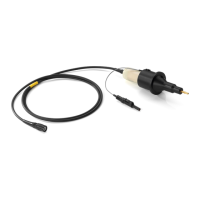Protocol Analysis
R&S
®
Scope Rider RTH
181User Manual 1326.1578.02 ─ 12
●
Addressing scheme: each slave device is addressable by a unique address. Multi-
ple slave devices can be linked together and can be addressed by the same mas-
ter.
●
Read/write bit: specifies if the master reads (=1) or writes (=0) the data.
●
Acknowledge: takes place after every byte. The receiver of the address or data
sends the acknowledge bit to the transmitter.
The R&S RTH supports all operating speed modes: high-speed, fast mode plus, fast
mode, and standard mode.
Data transfer
The format of a simple I²C message (frame) with 7-bit addressing consists of the fol-
lowing parts:
●
Start condition: a falling slope on SDA while SCL is high
●
7-bit address of the slave device that either is written to or read from
●
R/W bit: specifies if the data is written to or read from the slave
●
ACKnowledge bits: is issued by the receiver of the previous byte if the transfer was
successful
Exception: At read access, the master terminates the data transmission with a
NACK bit after the last byte.
●
Data: several data bytes with an ACK bit after every byte
●
Stop condition: a rising slope on SDA while SCL is high
Figure 9-7: I2C writes access with 7-bit address
Address types: 7-bit and 10-bit
Slave addresses can be 7 bits or 10 bits long. A 7-bit address requires 1 byte, 7 bits for
the address followed by the R/W bit.
A 10-bit address for write access requires 2 bytes: the first byte starts with the reserved
sequence 11110, followed by the two MSB of the address and the write bit. The second
byte contains the remaining 8 LSB of the address. The slave acknowledges each
address byte.
I2C (Option R&S
RTH-K1)

